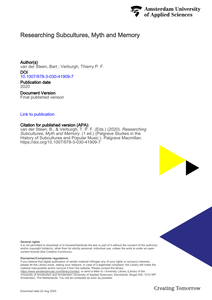Emissions from aviation will continue to increase in the future, in contradiction of global climate policy objectives. Yet, airlines and airline organisations suggest that aviation will become climatically sustainable. This paper investigates this paradox by reviewing fuel-efficiency gains since the 1960s in comparison to aviation growth, and by linking these results to technology discourses, based on a two-tiered approach tracing technology-focused discourses over 20 years (1994-2013). Findings indicate that a wide range of solutions to growing emissions from aviation have been presented by industry, hyped in global media, and subsequently vanished to be replaced by new technology discourses. Redundant discourses often linger in the public domain, where they continue to be associated with industry aspirations of 'sustainable aviation' and 'zero-emission flight'. The paper highlights and discusses a number of technology discourses that constitute 'technology myths', and the role these 'myths' may be playing in the enduring but flawed promise of sustainable aviation. We conclude that technology myths require policy-makers to interpret and take into account technical uncertainty, which may result in inaction that continues to delay much needed progress in climate policy for aviation.
LINK
The four previous articles in this series addressed the myths and facts surrounding lipoedema. We have shown that there is no scientific evidence at all for the key statements made about lipoedema-which are published time and time again. The main result of this misunderstanding of lipoedema is a therapeutic concept that misses the mark. The patient's real problems are overlooked. The national and especially the international response to the series, which can be read in both German and English, has been immense and has exceeded all our expectations. The numerous reactions to our articles make it clear that in other countries, too, the fallacies regarding lipoedema have led to an increasing discrepancy between the experience of healthcare workers and the perspective of patients and self-help groups, based on misinformation mostly generated by the medical profession. Parts 1 to 4 in this series of articles on the myths surrounding lipoedema have made it clear that we have to radically change the view of lipoedema that has been held for decades. Changing our perspective means getting away from the idea of oedema in lipoedema- A nd hence away from the dogma that decongestion is absolutely necessary- A nd towards the actual problems faced by our patients with lipoedema. Such a paradigm shift in a disease that has been described in the same way for decades cannot be left to individuals but must be put on a much broader footing. For this reason, the lead author of this series of articles invited renowned lipoedema experts from various European countries to discussions on the subject. Experts from seven different countries took part in the two European Lipoedema Forums, with the goal of establishing a consensus. The consensus reflects the experts' shared view on the disease, having scrutinized the available literature, and having taken into account the many years of clinical practice with this particular patient group. Appropriate to the clinical complexity of lipoedema, participants from different specialties provided an interdisciplinary approach. Nearly all of the participants in the European Lipoedema Forum had already published work on lipoedema, had been involved in drawing up their national lipoedema guidelines, or were on the executive board of their respective specialty society. In this fifth and final part of our series on lipoedema, we will summarise the relevant findings of this consensus, emphasising the treatment of lipoedema as we now recommend it. As the next step, the actual consensus paper European Best Practice of Lipoedema will be issued as an international publication. Instead of looking at the treatment of oedema, the consensus paper will focus on treatment of the soft tissue pain, as well as the psychological vulnerability of patients with lipoedema. The relationship between pain perception and the patient's mental health is recognised and dealt with specifically. The consensus also addresses the problem of self-acceptance, and this plays a prominent role in the new therapeutic concept. The treatment of obesity provides a further pillar of treatment. Obesity is recognised as being the most common comorbid condition by far and an important trigger of lipoedema. Bariatric surgery should therefore also be considered for patients with lipoedema who are morbidly obese. The expert group upgraded the importance of compression therapy and appropriate physical activity, as the demonstrated anti-inflammatory effects directly improve the patients' symptoms. Patients will be provided with tools for personalised self-management in order to sustain sucessful treatment. Should conservative therapy fail to improve the symptoms, liposuction may be considered in strictly defined circumstances. The change in the view of lipoedema that we describe here brings the patients' actual symptoms to the forefront. This approach allows us to focus on more comprehensive treatment that is not only more effective but also more sustainable than focusing on the removal of non-existent oedema.
DOCUMENT
This book brings together contributions that analyse how subcultural myths develop and how they can be studied. Through critical engagement with (history) writing and other sources on subcultures by contemporaries, veterans, popular media and researchers, it aims to establish: how stories and histories of subcultures emerge and become canonized through the process of mythification; which developments and actors are crucial in this process; and finally how researchers like historians, sociologists, and anthropologists should deal with these myths and myth-making processes. By considering these issues and questions in relation to mythmaking, this book provides new insights on how to research the identity, history, and cultural memory of youth subcultures.
DOCUMENT
